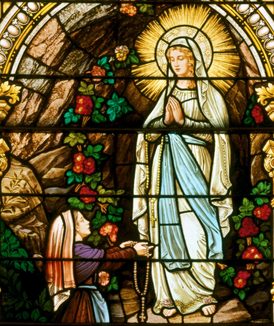
You have been blessed, O Virgin Mary, above all other women on earth by the Lord the most high God; he has so exalted your name that your praises shall never fade from the mouths of men.
In the recent weeks I've had to think more about the place of Mary, Mother of God (Theotokos) in Catholic theology, worship and personal devotion. This was especially keen when I took the negative position of a resolution on the worthiness of a believer's adherence to the phenomenon of Medjugorje. Marian piety is a strong reality in Catholicism and no good Catholic can claim being in communion with the believing community of faith if there is no adherence to some form of devotion to the Mother of God, Mary the Virgin. Today, the Church honors the Blessed Virgin Mary of Lourdes. Let me pose a points on what we believe viz. Marian doctrine.
We can begin thinking about the BVM in sacred Scripture, (e.g., the Annunciation or at the cross) the Apostolic Fathers and beyond but I want to limit ourselves to the Second Vatican Council and a other notable teachers of the Faith. Vatican II teaches us that Our Lady's intercession before the Throne of Grace is, in fact, long standing. Pope Paul VI speaks of Mary as the intercessor for unity among Christians and world peace, ultimately giving her the title of "Queen of Peace" (see the 1974 document Marialis cultus, 5 & 33). Developing the them of Mary's maternity based on Vatican II thinking, Pope John Paul II in his encyclical 1980 Dives in misericordia (no. 9) claims for us that Mary's motherhood the eternal Word of God has a special place in our own redemption. In other places John Paul also speaks of Mary's assistance in ecumenical work as the "Mother of Unity" and he reaffirms Pope Paul's "Queen of Peace" title.
Catholics always make distinctions. We have "public revelation" and "private revelation" when it comes to matters of faith and salvation. The teaching of the Church says that public revelation ended with the death of Saint John, the beloved disciple and evangelist. With John's death revelation is said to be closed as there were no other direct witnesses to the Resurrection of Jesus from the dead. Revelation, here, contains all that God has revealed to us in His Son, Jesus Christ. Since Christ established a Church to continue the ongoing work of salvation public revelation means that it is contained in sacred Scripture, Tradition and the Teaching of the Church: what has been handed down from Jesus, to the Apostles to the bishops and to us. We believe, therefore, that Jesus Christ is the fullness of revelation; He is the definitive revelation of God.
Revelation is considered private when something of the Paschal Mystery (the life, death, resurrection and ascension) of the Lord is made known to a saint, to Mary, or through contemplative prayer. While the Apostles were alive revelation continued to reveal some specific about the Lord as it concerns our salvation while private revelation does not add anything to what is already revealed in the public revelation. The contribution to our spiritual lives that a private revelation makes is a certain guidance, application, correction or exhortation. As examples of this would be the 14 Marian apparitions and saints like Faustina, Catherine of Siena, Margaret Mary Alacoque and Catherine Labouré. While all of things these saints have revealed to us assist us in our faith they are considered to be private revelation but with a prophetic quality to them. But the Church does not bind our consciences to believe these private revelations because they are not part of the revelation given to us through the apostles.
Private revelation, nonetheless, has a special place in theological reflection and must be considered sympathetically as there is an element of private revelation that is prophetic. Saint Thomas Aquinas writes, "in every period there have always been some who have the spirit of prophecy, not to set forth new teaching of the faith, but to give direction to human activities" (Summa theologiae II-II, 174, 6 ad 3).
The feast of Our Lady of Lourdes leads us to recall the infallible doctrine of the Immaculate Conception of Mary. This feast reminds us of the extraordinary events in 1858 when the Virgin Mary identified herself to Bernadette Soubirous on the banks of the Gave River near Lourdes, France as the Immaculate Virgin. The apparition of the Immaculate Virgin Mary came four years after the Church promulgated the dogma of the Immaculate Conception.
There were 18 apparitions with the last one on July 16, 1858.
The message given to Bernadette at Lourdes is a Gospel message: Mary calls all people to believe in the Gospel and always keeping in mind that God loves and cares for each of us. It is a "Prodigal Son" message of calling back sinners to a loving Father. This road of conversion to Christ is a personal, intimate encounter with the Lord. It is lived in the faith community of the Church. This is a message of healing of the heart and not only physical healing, which is one way of manifesting a spiritual healing. God's healing of the heart goes to the deepest places where we are often unaware.
Our prayer, then, is what the Church prays at Mass:
God of mercy, we celebrate the feast of Mary, the sinless mother of God. May her prayers help us to rise above our human weakness.
The story of Lourdes can be viewed here.
The story of the 67 miracles of Lourdes can heard here.
About the documentary of Lourdes.


Leave a comment